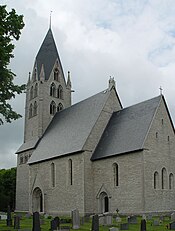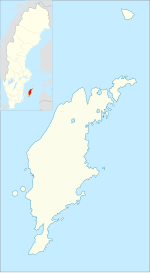Dalhem Church
| Dalhem Church | |
|---|---|
| Dalhem kyrka | |

Dalhem Church, external view
|
|
| 57°33′09″N 18°32′03″E / 57.5524°N 18.5341°ECoordinates: 57°33′09″N 18°32′03″E / 57.5524°N 18.5341°E | |
| Country | Sweden |
| Denomination | Church of Sweden |
| Administration | |
| Diocese | Visby |
Dalhem Church (Swedish: Dalhems kyrka) is a medieval Lutheran church in Dalhem on the Swedish island of Gotland, in the Diocese of Visby.
The very first church on the site was a stave church, now vanished. This was followed by small stone church on the same site. This church, probably Romanesque in style, seems to have had a choir with an apse. In the presently visible church, the choir and nave are the oldest parts, dating from the 13th century. The tower, the main portal and the large window on the western façade date from the 14th century. The construction was led by Cistercian monks from nearby Roma Abbey. The church was subsequently left more or less unchanged, with only some furnishings – notably, the carved wooden pulpit (1637) – being added later. In 1899 a major renovation of the church started, which to a large degree transformed the church.
In 1899 a renovation of the church began. The architect and artist Axel Herman Hägg collected money, also internationally, for the thorough undertaking. The work continued for fifteen years, until 1914. The church was substantially altered both externally and internally, in an attempt to make the church appear even more medieval. The renovation was considered remarkable at the time, and led to the church being called the "national shrine of Gotland". Today, the renovation has been described instead as a "harsh and loose reconstruction of the Middle Ages". It remains an interesting example of the ideas of cultural heritage conservation prevalent at the time.
The church consists of three distinct parts: the tower, nave and choir. The tower, which reaches over 50 metres (160 ft) is adorned with galleries, an influence of art from the Rhine valley and topped with a form of spire known as a Rhenish helm. The main portal, on the south façade, is decorated with carved stone sculptures with motifs unusual for Gotland (14th century). In the wall adjacent to the northern portal, a tombstone originating from the earlier stone church has been immured. The exterior of the church has been whitewashed but the underlying limestone was laid bare during the 1899–1914 renovation.
...
Wikipedia

